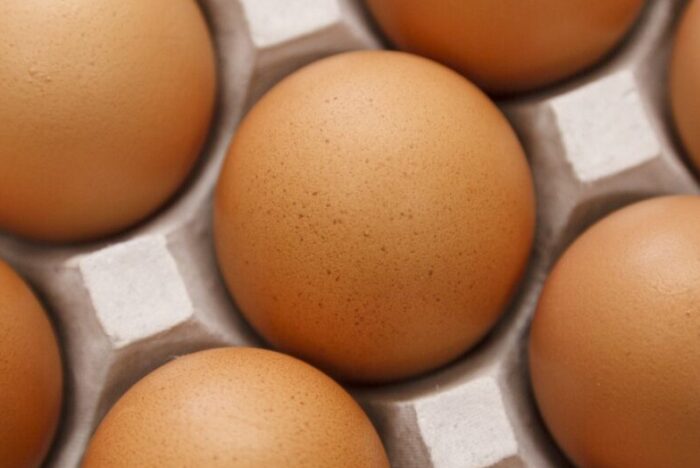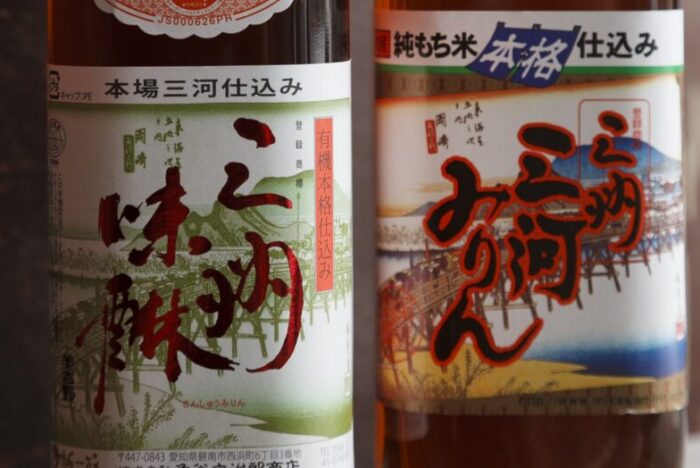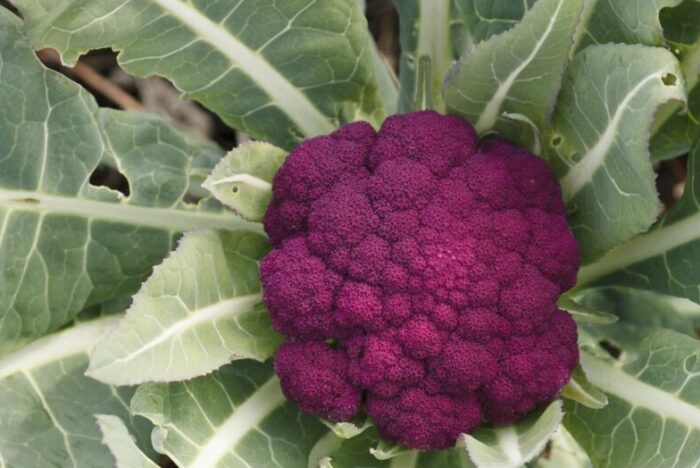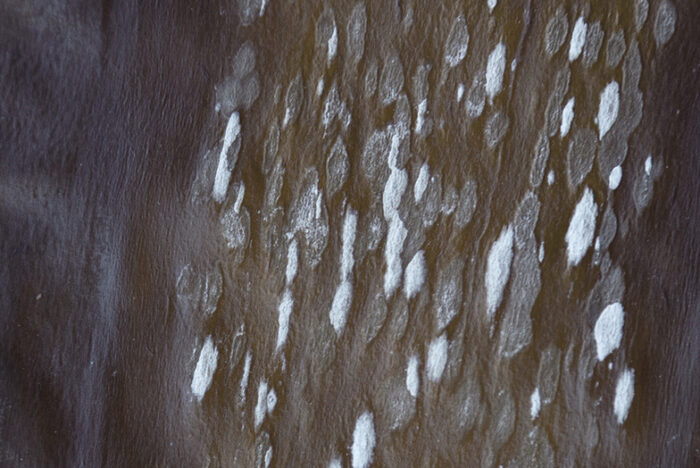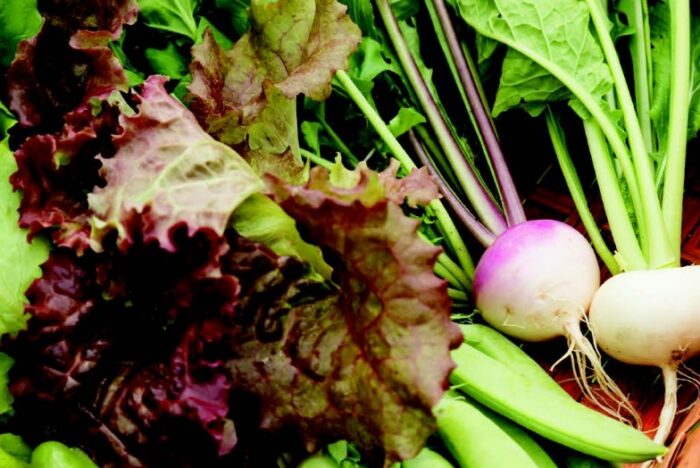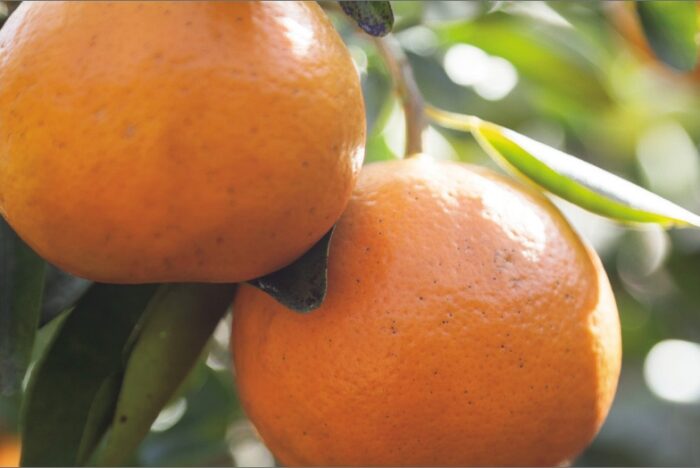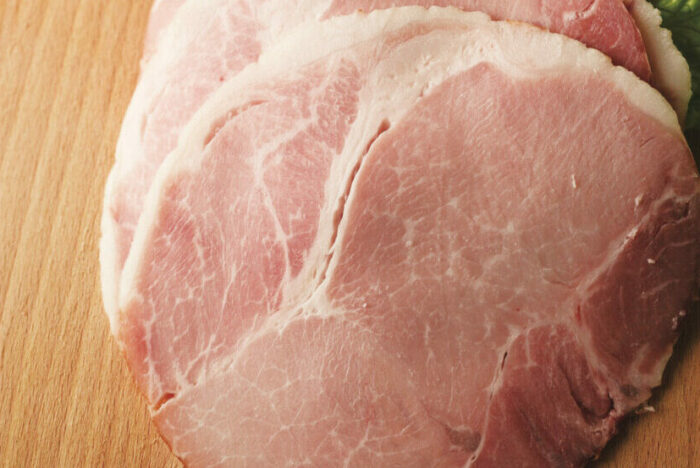Wakayama-made ingredients cross the sea
Report from a Tasting Event in Singapore
2014.03.06
Seeking to expand sales markets overseas, Wakayama prefecture has targeted Singapore, a leading economic power of Asia. The following details a tasting event to deliver the delicious flavors of Wakayama to Singaporeans.
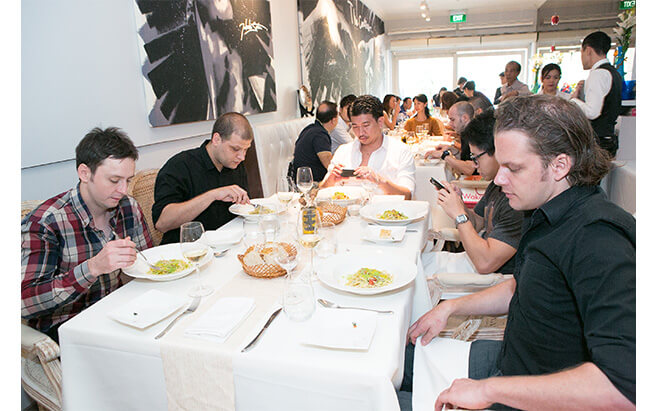 |
Photographs by James Ong |
Singapore is a leading market of the Asian economy and is also known as a gastronomic mecca, from which ten local restaurants were selected as part of Asia’s 50 Best Restaurants. In order to introduce the excellent taste of Wakayama products to Singaporeans of discerning taste, the prefecture held a tasting event featuring products from the farms and seas of Wakayama on January 25, 2014 at Enoteca L’Operetta, an Italian restaurant located in Singapore. Around 20 people were in attendance, including local Italian, French and Japanese chefs, as well as other distinguished figures involved in the food industry.
Italian created with the bounty of Wakayama
Seita Nakahara, executive chef of Enoteca L’Operetta, prepared the cuisine. Spending his junior high and high school days in Singapore, he later became a chef of Italian cuisine in Tokyo. He trained for four years in Italy, and has worked at Enoteca L’Operetta since 2009. He is a promising young chef who has been selected as a recipient of the Gold Egg in 2013 in the RED U-35, a young chef competition. Chef Seita visited Wakayama before the testing event and interacted with local food producers.
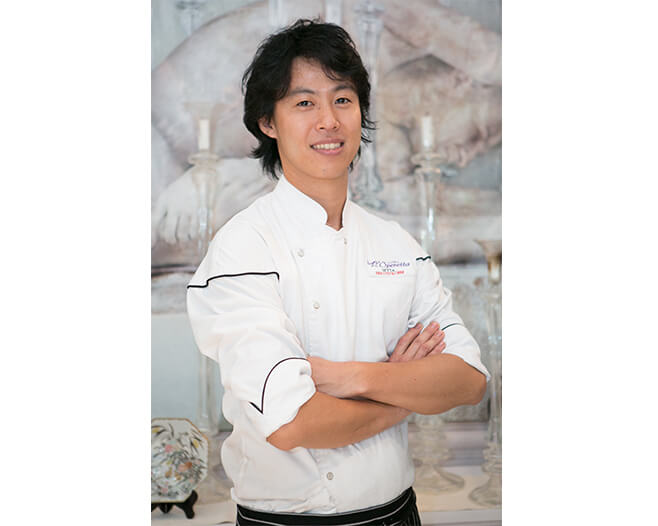 |
Seita Nakahara, executive chef of Enoteca L’Operetta |
“I thought about how I could best make use of the taste of the products grown with loving care by local producers to make tasty dishes, without working on them too much.” Chef Seita incorporated these treasures of Wakayama, which included tuna and other seafood, vegetables and fruits, into his Italian cuisine.
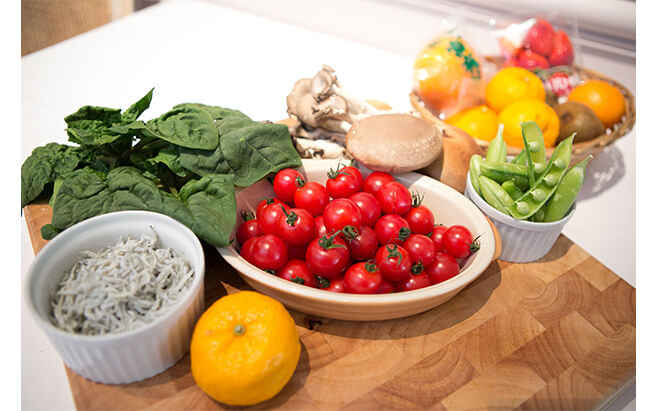 |
Wakayama products used for the event ( a part of them ) |
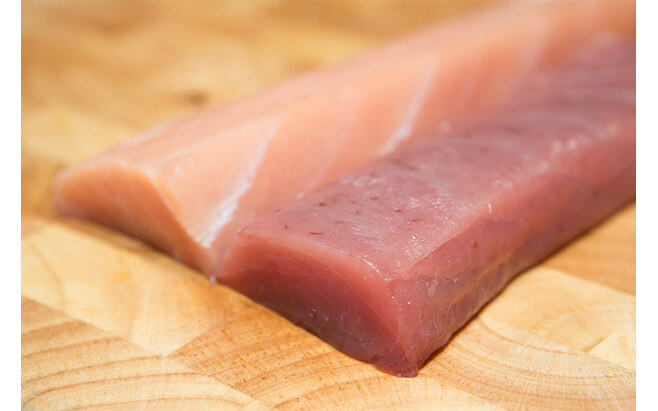 |
Fresh tuna from Wakayama |
Cutting-edge technology preserves the taste of tuna
Tuna and marlin caught and refrigerated at the fishing port of Katsuura were used for the dish “Tartar steak of bigeye and marlin with Trapanese sauce saffron”. The latest in refrigeration technology, developed by middleman Yamasa Wakiguchi Suisan, allows anyone to easily thaw frozen fish without excess water drip. Frozen storage of the tastiest seasonal tuna ensures a reliable supply, both in terms of quality and quantity. As a taste comparison, Seita sampled both raw tuna and tuna which had been refrigerated by Yamasa Wakiguchi Suisan. “The refrigerated tuna is quite good. There may be strong demand overseas for tuna using this technology.” He also explained this refrigeration technology during the tasting event with the frozen tuna on hand.
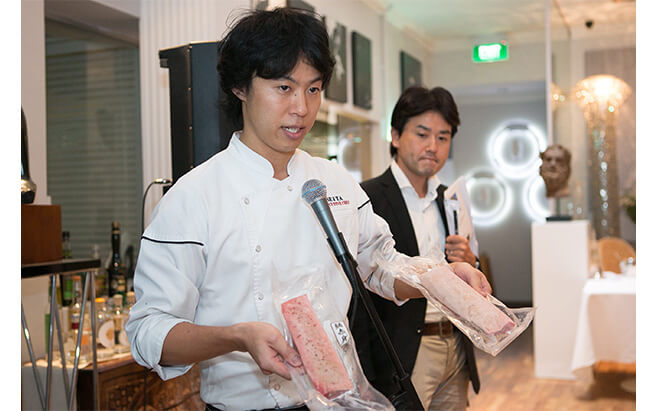 |
Chef Seita addresses the participants, showing the frozen tuna |
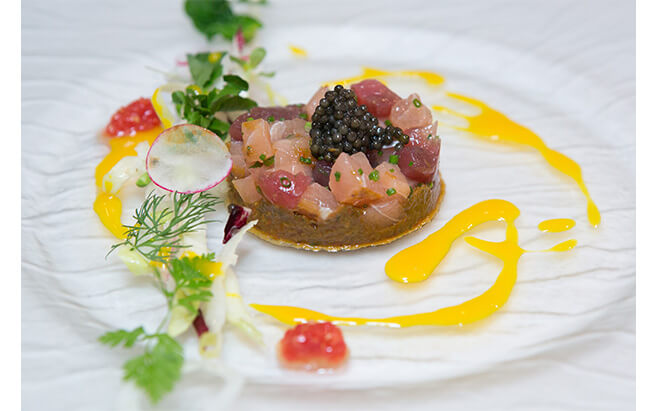 |
Sicillian style tuna tartar served with saffron rice sauce |
The ingredients used were Yutosei (tomato), Chijimihorenso (shrunken spinach), bigeye and marlin. The bigeye and marlin were used for tartar steak, and an almond and tomato-based Trapanese sauce added spice to the taste of the tuna. He came upon the idea of adding the flavor of the rice to the dish while in Wakayama.
Paul Longworth, executive chef of French restaurant “Au Petit Salut” stated, “The tuna is so fresh and flavorful, and is excellent with the sauce. I have never used tuna in my restaurant, but would certainly like to try in the future.”
Felix Chong, a chef of Italian restaurant “inITALY” and currently preparing for the opening of a new eatery, showed an interest in the food, saying, “The taste was delicate. Until now I have felt uncomfortable using refrigerated fish, but would like to try it in our new restaurant if the quality is stable and thawing process is manageable.”
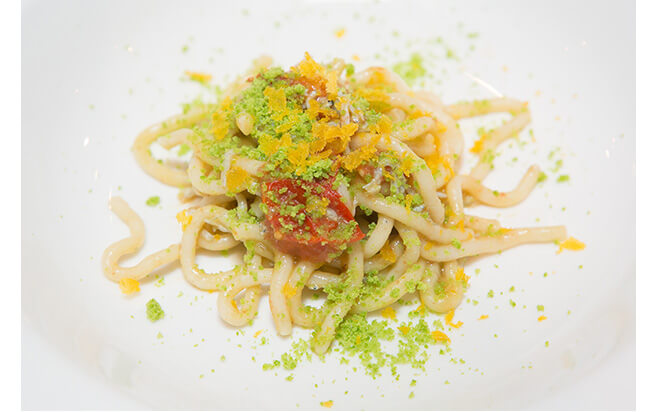 |
Homemade pasta with whitebait and greenpeas powder |
Bigoli, pasta formed with the Toruchio (a pressing machine) with whitebait and tomato confits. Dried and ground peas add a fresh green. All ingredients used, i.e. whitebait, Usuiendo (peas), Yutosei (tomatoes) and yuzu citrons, are from Wakayama.
Sandro Falbo, Fullerton Hotel executive chef, praised the ingredients, saying, “The whitebait is soft and fragrant, forming a delicate taste. I’m very interested in this, as good quality whitebait is hard to find. The tomatoes (Yutosei) possess a favorable balance of sweet and sour, reminding me of those in my Italian homeland.”
A local sweets-making demonstration of"Wakayama Punch"
For the dessert, Yoshio Koyama of Wakayama’s South West Café, demonstrated how to make “Wakayama Punch,” a sweet made with local fruit such as strawberries, persimmons, kiwis and tangerines to promote the wide variety of Wakayama-grown fruit.
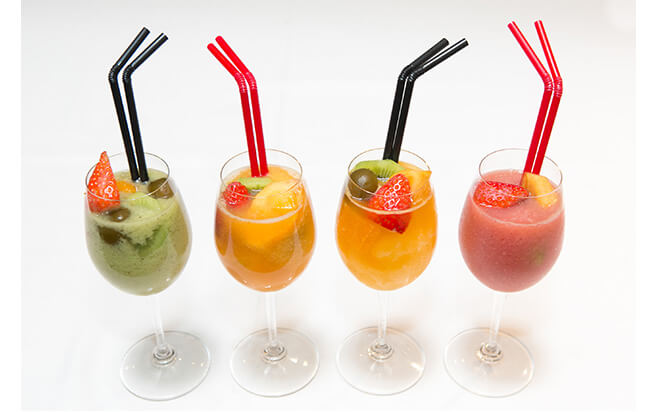 |
“Wakayama Punch” filled with home-grown Wakayama fruit |
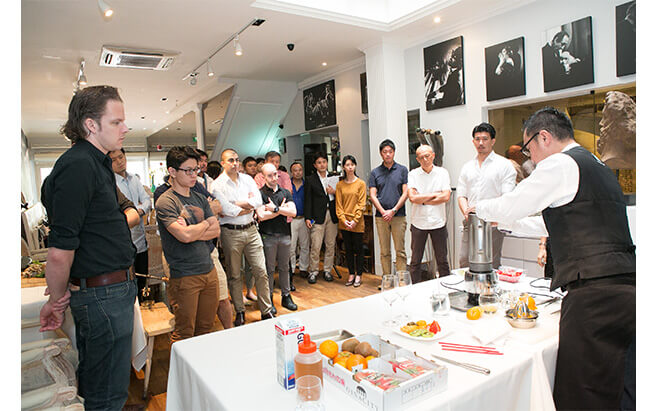 |
A demonstration in the making of “Wakayama Punch” |
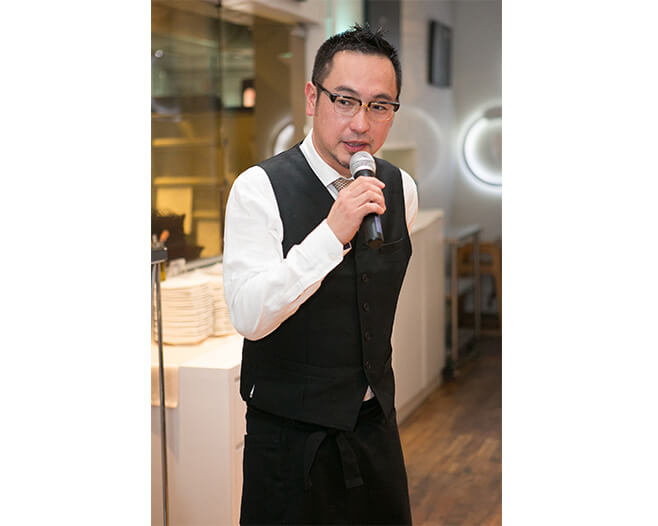 |
Mr. Koyama flew in from Japan at his own expense to participate in the event in order to “promote the charm of Wakayama fruit internationally.” |
“Wakayama Punch” is a dessert made by like-minded people (such as restaurant owners, elementary school students and teachers and school nutritionists) sharing a love for Wakayama to promote the local brand. The definition of Wakayama Punch is a dessert in which one or more varieties of Wakayama Plum, candied or preserved in syrup, and one or more other kinds of Wakayama fruit are used, and the restaurant menu clearly states that it is a product of Wakayama.
Wakayama brands foray onto the world stage
The “Wakayama Week” was held at Enoteca L’Operetta from Monday, February 24 to Saturday, March 1, 2014 to spread the word among consumers about the appeal of Wakayama produce. Comments Seita, “After visiting Wakayama, I am now fully confident in spreading the word about its wonderful ingredients. I would like to continue communicating the essence of Wakayama through its produce to diners that try them for the first time.”
The course menu is as follows:
For starter
Sicillian style tuna tartar served with saffron rice sauce
For pasta
Homemade pasta with whitebait and greenpeas powder
For main
Net catch grilled turbot served with celeriac purée and sweet spinach
For dessert
Strawberry sorbet with white chocolate sauce
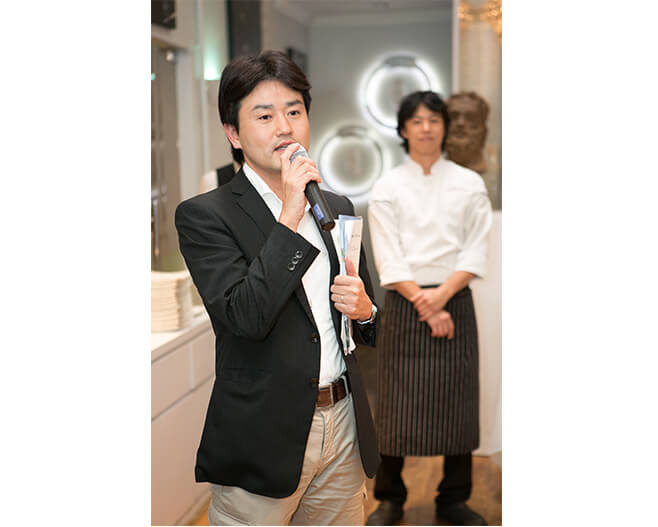 |
Takashi Oishi, Distribution Division, Agriculture, Forestry and Fisheries Department, Wakayama Prefecture introduced ingredients produced in Wakayama Prefecture. |
For the prefecture of Wakayama, riding high on the success of its foray into Singapore, the challenge of global expansion continues.
Seeking to expand sales markets overseas, Wakayama prefecture has targeted Singapore, a leading economic power of Asia. The following details a tasting event to deliver the delicious flavors of Wakayama to Singaporeans.
 |
Photographs by James Ong |
Singapore is a leading market of the Asian economy and is also known as a gastronomic mecca, from which ten local restaurants were selected as part of Asia’s 50 Best Restaurants. In order to introduce the excellent taste of Wakayama products to Singaporeans of discerning taste, the prefecture held a tasting event featuring products from the farms and seas of Wakayama on January 25, 2014 at Enoteca L’Operetta, an Italian restaurant located in Singapore. Around 20 people were in attendance, including local Italian, French and Japanese chefs, as well as other distinguished figures involved in the food industry.
Italian created with the bounty of Wakayama
Seita Nakahara, executive chef of Enoteca L’Operetta, prepared the cuisine. Spending his junior high and high school days in Singapore, he later became a chef of Italian cuisine in Tokyo. He trained for four years in Italy, and has worked at Enoteca L’Operetta since 2009. He is a promising young chef who has been selected as a recipient of the Gold Egg in 2013 in the RED U-35, a young chef competition. Chef Seita visited Wakayama before the testing event and interacted with local food producers.
 |
Seita Nakahara, executive chef of Enoteca L’Operetta |
“I thought about how I could best make use of the taste of the products grown with loving care by local producers to make tasty dishes, without working on them too much.” Chef Seita incorporated these treasures of Wakayama, which included tuna and other seafood, vegetables and fruits, into his Italian cuisine.
 |
Wakayama products used for the event ( a part of them ) |
 |
Fresh tuna from Wakayama |
Cutting-edge technology preserves the taste of tuna
Tuna and marlin caught and refrigerated at the fishing port of Katsuura were used for the dish “Tartar steak of bigeye and marlin with Trapanese sauce saffron”. The latest in refrigeration technology, developed by middleman Yamasa Wakiguchi Suisan, allows anyone to easily thaw frozen fish without excess water drip. Frozen storage of the tastiest seasonal tuna ensures a reliable supply, both in terms of quality and quantity. As a taste comparison, Seita sampled both raw tuna and tuna which had been refrigerated by Yamasa Wakiguchi Suisan. “The refrigerated tuna is quite good. There may be strong demand overseas for tuna using this technology.” He also explained this refrigeration technology during the tasting event with the frozen tuna on hand.
 |
Chef Seita addresses the participants, showing the frozen tuna |
 |
Sicillian style tuna tartar served with saffron rice sauce |
The ingredients used were Yutosei (tomato), Chijimihorenso (shrunken spinach), bigeye and marlin. The bigeye and marlin were used for tartar steak, and an almond and tomato-based Trapanese sauce added spice to the taste of the tuna. He came upon the idea of adding the flavor of the rice to the dish while in Wakayama.
Paul Longworth, executive chef of French restaurant “Au Petit Salut” stated, “The tuna is so fresh and flavorful, and is excellent with the sauce. I have never used tuna in my restaurant, but would certainly like to try in the future.”
Felix Chong, a chef of Italian restaurant “inITALY” and currently preparing for the opening of a new eatery, showed an interest in the food, saying, “The taste was delicate. Until now I have felt uncomfortable using refrigerated fish, but would like to try it in our new restaurant if the quality is stable and thawing process is manageable.”
 |
Homemade pasta with whitebait and greenpeas powder |
Bigoli, pasta formed with the Toruchio (a pressing machine) with whitebait and tomato confits. Dried and ground peas add a fresh green. All ingredients used, i.e. whitebait, Usuiendo (peas), Yutosei (tomatoes) and yuzu citrons, are from Wakayama.
Sandro Falbo, Fullerton Hotel executive chef, praised the ingredients, saying, “The whitebait is soft and fragrant, forming a delicate taste. I’m very interested in this, as good quality whitebait is hard to find. The tomatoes (Yutosei) possess a favorable balance of sweet and sour, reminding me of those in my Italian homeland.”
A local sweets-making demonstration of"Wakayama Punch"
For the dessert, Yoshio Koyama of Wakayama’s South West Café, demonstrated how to make “Wakayama Punch,” a sweet made with local fruit such as strawberries, persimmons, kiwis and tangerines to promote the wide variety of Wakayama-grown fruit.
 |
“Wakayama Punch” filled with home-grown Wakayama fruit |
 |
A demonstration in the making of “Wakayama Punch” |
 |
Mr. Koyama flew in from Japan at his own expense to participate in the event in order to “promote the charm of Wakayama fruit internationally.” |
“Wakayama Punch” is a dessert made by like-minded people (such as restaurant owners, elementary school students and teachers and school nutritionists) sharing a love for Wakayama to promote the local brand. The definition of Wakayama Punch is a dessert in which one or more varieties of Wakayama Plum, candied or preserved in syrup, and one or more other kinds of Wakayama fruit are used, and the restaurant menu clearly states that it is a product of Wakayama.
Wakayama brands foray onto the world stage
The “Wakayama Week” was held at Enoteca L’Operetta from Monday, February 24 to Saturday, March 1, 2014 to spread the word among consumers about the appeal of Wakayama produce. Comments Seita, “After visiting Wakayama, I am now fully confident in spreading the word about its wonderful ingredients. I would like to continue communicating the essence of Wakayama through its produce to diners that try them for the first time.”
The course menu is as follows:
For starter
Sicillian style tuna tartar served with saffron rice sauce
For pasta
Homemade pasta with whitebait and greenpeas powder
For main
Net catch grilled turbot served with celeriac purée and sweet spinach
For dessert
Strawberry sorbet with white chocolate sauce
 |
Takashi Oishi, Distribution Division, Agriculture, Forestry and Fisheries Department, Wakayama Prefecture introduced ingredients produced in Wakayama Prefecture. |
For the prefecture of Wakayama, riding high on the success of its foray into Singapore, the challenge of global expansion continues.


